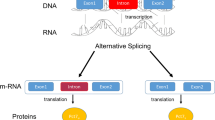Abstract
It is frequently said that biology is emerging from a long phase of reductionism. It would be certainly more correct to say that biologists are abandoning a certain form of reductionism. We describe this past form, and the experiments which challenged the previous vision. To face the difficulties which were met, biologists use a series of concepts and metaphors - pleiotropy, tinkering, epigenetics - the ambiguity of which masks the difficulties, instead of solving them. In a similar way, the word “post-genomics” has different meanings, depending upon who uses it. Which of these meanings will become dominant in the future is an open question.
Similar content being viewed by others
References
Allen G.E. (1978). Thomas H. Morgan, The man and his science (p. 270). Princeton, NJ Princeton University Press
Allen G.E. (2000). The reception of Mendelism in the United States, 1900–1930. Comptes Rendus de l’ Academic des Sciences. Paris, Sciences de la vie, 323: 1081–1088
Brown P.O., Botstein D. (1999). Exploring the new world of the genome with DNA arrays. Nature Genetics Supplement, 21, 33–37
Fischer E.P., Lipson C. (1988). Thinking about science: Max Delbrück and the origins of molecular biology. New York, W. W. Norton
Greenspan R.J. (2001). The flexible genome. Nature Reviews/Genetics, 2, 383–387
Jacob F. (1973). The logic of life. Princeton, NJ Princeton University Press
Jacob F. (1977). Evolution and tinkering. Science, 196, 1161–1166
Jasny B.R., Ray L.B. (2003). Life and the art of networks. Science, 301: 1863 et s
Keller E.F. (1995). Refiguring life: Metaphors of twentieth century biology. New York, Columbia University Press
Kuhn T.S. (1970). The structure of scientific revolutions. Chicago, University of Chicago Press
Lawrence P.A. (2001). Science or alchemy?. Nature Reviews/Genetics, 2, 139–141
Morange M. (2000). Gene action. Comptes Rendus de l’ Academic des Sciences. Paris, Sciences de la vie, 323, 1147–1153
Morange, M. (2002). The relations between genetics and epigenetics: a historical point of view. In L. van Speybroeck, G. van de Vijver, & D. de Waele (Eds.), From epigenesis to epigenetics Annals of the New York Acadamy of Sciences (Vol. 981, pp. 50–60).
Morange M. (2003). La vie expliquée? 50 ans après la double hélice. Paris, Odile Jacob
Moss L. (2002). What genes can’t do. Cambridge, Mass MIT Press
Waddington C. (1942). L’épigénotype. Endeavour, 1, 18–20
Author information
Authors and Affiliations
Corresponding author
Rights and permissions
About this article
Cite this article
Morange, M. Post-genomics, between reduction and emergence. Synthese 151, 355–360 (2006). https://doi.org/10.1007/s11229-006-9029-9
Published:
Issue Date:
DOI: https://doi.org/10.1007/s11229-006-9029-9




